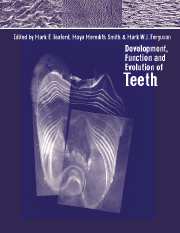Book contents
- Frontmatter
- Contents
- List of contributors
- Acknowledgements
- Part one Genes, molecules and tooth initiation
- Part two Tooth tissues: development and evolution
- 5 Evolutionary origins of dentine in the fossil record of early vertebrates: diversity, development and function
- 6 Pulpo-dentinal interactions in development and repair of dentine
- 7 Prismless enamel in amniotes: terminology, function, and evolution
- 8 Two different strategies in enamel differentiation: Marsupialia versus Eutheria
- 9 Incremental markings in enamel and dentine: what they can tell us about the way teeth grow
- Part three Evolution of tooth shape and dentition
- Part four Macrostructure and function
- Index
9 - Incremental markings in enamel and dentine: what they can tell us about the way teeth grow
Published online by Cambridge University Press: 11 September 2009
- Frontmatter
- Contents
- List of contributors
- Acknowledgements
- Part one Genes, molecules and tooth initiation
- Part two Tooth tissues: development and evolution
- 5 Evolutionary origins of dentine in the fossil record of early vertebrates: diversity, development and function
- 6 Pulpo-dentinal interactions in development and repair of dentine
- 7 Prismless enamel in amniotes: terminology, function, and evolution
- 8 Two different strategies in enamel differentiation: Marsupialia versus Eutheria
- 9 Incremental markings in enamel and dentine: what they can tell us about the way teeth grow
- Part three Evolution of tooth shape and dentition
- Part four Macrostructure and function
- Index
Summary
Introduction
Those who study human evolution do so for one, or more, of several reasons. For many, the primary goal is to define phylogenetic relationships between species of fossil hominids. For others, the human fossil record provides unique insights into primate biology that help us understand living primates in a wider context. Some view the fossil record differently. It represents one way in which we can begin to understand the mechanisms that underlie morphological change during evolution. In fact, the hominoid fossil record preserves a few details that allow us to determine the ways in which tooth tissues grow after ameloblasts and odontoblasts have become fully differentiated. In recent years, developmental biologists have come much closer to understanding the mechanisms of certain key embryological processes. Evolutionary biologists have also come closer to explaining how morphological change comes about during evolution. Identifying the common processes in ontogeny that regulate and control morphological change during phylogeny is once again one of the primary goals in evolutionary biology.
With regard to teeth and jaws, there has been an explosion of knowledge about their embryonic development and about morphogenesis of different tooth types (see Zhao, Weiss and Stock, chapter 11) as well as about the control of dental patterns at the molecular level (see Weiss, 1993; Chapter 5.1, 2). Studies in the embryo of individual rhombomeric crest populations are beginning to establish ultimate homologies between cranial elements and to elucidate which molecular pathways have changed during vertebrate evolution (Koentges and Lumsden, 1996).
- Type
- Chapter
- Information
- Development, Function and Evolution of Teeth , pp. 119 - 130Publisher: Cambridge University PressPrint publication year: 2000
- 38
- Cited by



